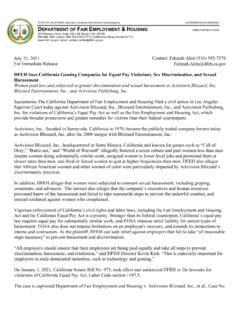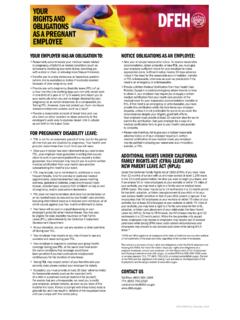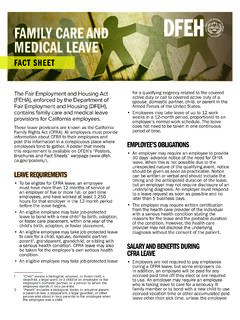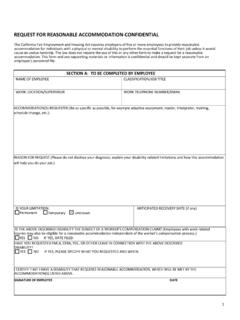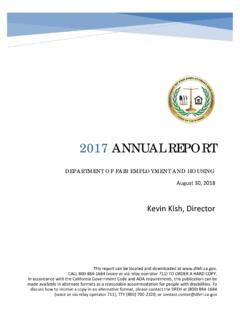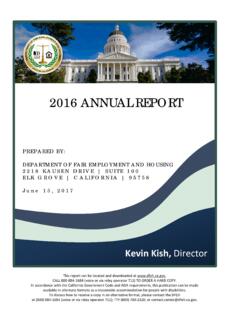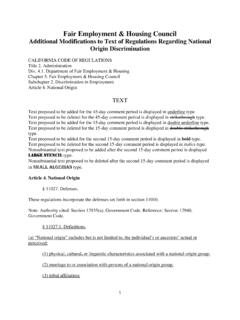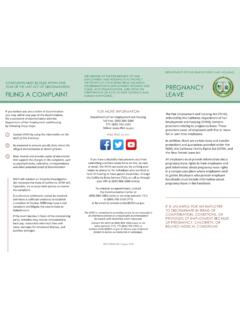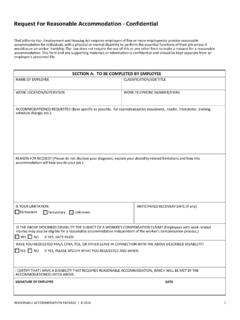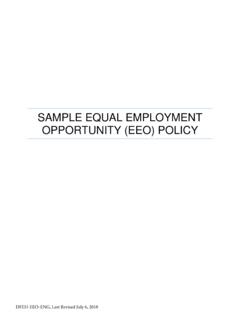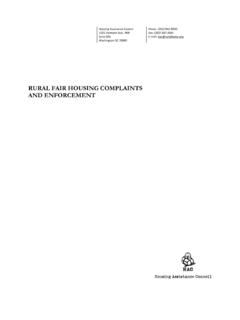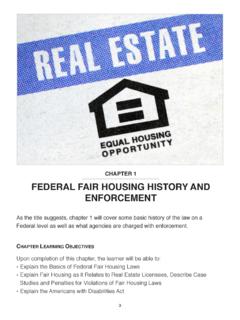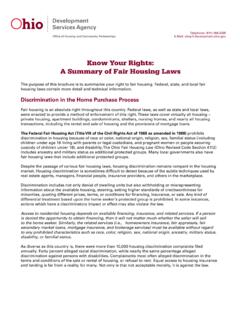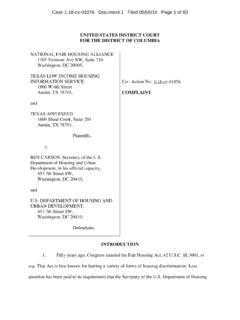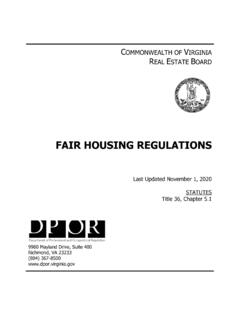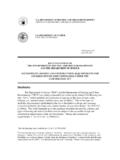Transcription of Text - Fair Housing Regulations
1 1 fair Employment & Housing Council fair Housing Regulations CALIFORNIA CODE OF Regulations Title 2. Administration Div. Department of fair Employment & Housing Chapter 5. fair Employment & Housing Council Subchapter 7. Discrimination in Housing TEXT [All additions to the CA Code of Regulations ] Article 1. General Matters 12000-12004. [Reserved] 12005. Definitions. As used in this subchapter, the following definitions shall apply: (a) Adverse action means action that harms or has a negative effect on an aggrieved person. The adverse action need not be related directly to the dwelling or Housing opportunity forming the basis for the lawsuit or administrative complaint; for example, filing false allegations about a tenant with a tenant s employer may constitute adverse action.
2 Adverse action includes: (1) In dwellings that are rented, leased, or otherwise made available for occupancy whether or not for a fee, adverse actions include: (A) Failing or refusing to rent or lease real property, failing or refusing to continue to rent or lease real property, failing or refusing to add a household member to an existing lease, reducing any tenant subsidy, increasing the rent, reducing services, changing the terms, conditions, or privileges, threatening to or actually filing false reports with tenant reporting agencies, unlawfully locking an individual out of, or otherwise restricting, access to all or part of the premises, harassment, termination, or threatened termination of tenancy, serving a notice to quit, filing an eviction action, evicting a tenant, refusing to provide a reasonable accommodation or reasonable modification, or engaging in any other discriminatory Housing practice.
3 And (B) Taking any action prohibited by California Civil Code sections (a), (b), , or (c) or (e), or Code of Civil Procedure (a); (2) Taking any action prohibited by Article 24 regarding the consideration of criminal history information; 2 (3) Refusing to sell a dwelling or residential real estate or otherwise failing or refusing to enter into a residential real estate related transaction; (4) Refusing to provide financial assistance related to a dwelling or residential real estate; or (5) Taking other action that has an adverse effect on an aggrieved person. (b) Aggrieved person includes any person who: (1) Believes they have been injured by a discriminatory Housing practice; or (2) Believes that they will be injured by a discriminatory Housing practice that is about to occur.
4 (c) Arrest means a record from any jurisdiction that does not result in a conviction and includes information indicating that an individual has been questioned, apprehended, taken into custody or detained, or held for investigation by a law enforcement, police, military, or prosecutorial agency, and/or charged with or indicted for any felony, misdemeanor or other criminal offense. (d) Assistance animal means an animal that is necessary as a reasonable accommodation for an individual with a disability. See also, section 12185. Assistance animals include service animals and support animals. An assistance animal is not a pet. It is an animal that works, provides assistance, or performs tasks for the benefit of an individual with a disability, or provides emotional support that alleviates one or more identified symptoms or effects of an individual s disability.
5 (1) Service animals are animals that are trained to perform specific tasks to assist individuals with disabilities, including individuals with mental health disabilities. Service animals do not need to be professionally trained or certified, but may be trained by the individual with a disability or another individual. Specific examples include, but are not limited to: (A) Guide dog, as defined at Civil Code section , or other animal trained to guide a blind individual or individual with low vision. (B) Signal dog, as defined at Civil Code section , or other animal trained to alert a deaf or hard-of-hearing individual to sounds. (C) Service dog, as defined at Civil Code section , or other animal individually trained to the requirements of an individual with a disability.
6 (D) Miniature horses meeting the requirements of 28 CFR (i) and 28 CFR (c)(9). 3 (E) Service animals in training, including guide, signal, and service dogs being trained by individuals with disabilities, persons assisting individuals with disabilities, or authorized trainers under Civil Code sections (c) and (b). (2) Support animals are animals that provide emotional, cognitive, or other similar support to an individual with a disability. A support animal does not need to be trained or certified. Support animals are also known as comfort animals or emotional support animals. (e) Building means a structure, facility, or portion thereof that contains or serves one or more dwelling units. (f) Business establishment shall have the same meaning as in Section 51 of the Civil Code.
7 Business establishments include persons engaged in the operation of a business covered by Section 51 of the Civil Code, insofar as the business is related to dwellings, Housing opportunities, financial assistance, land use, or residential real estate-related activities. The term business establishment shall be broadly interpreted. For example: (1) The rental, sale, management or operation of residential real estate, including common interest developments and mobilehome parks, constitute business establishments; (2) Government bodies engaged in enacting legislation to implement governmental functions may not constitute business establishments, but they may be a business establishment if they operate a business such as a shop in a government building; and (3) Both nonprofit and for-profit organizations can constitute business establishments depending on the facts, but truly private social clubs not engaged in business activity are not business establishments.
8 (g) Common use areas means rooms, spaces, or elements inside or outside of a building that are made available for the use of residents of a building or the guests thereof. Examples of common use areas include hallways, lounges, lobbies, laundry rooms, refuse rooms, mail rooms, elevators, parking areas, garages, pools, clubhouses, dining areas, physical fitness areas or gyms, play areas, recreational areas, and passageways among and between buildings. (h) Complainant means a person who files a complaint with the department alleging that the person has been aggrieved by a practice made unlawful by any law the department enforces. (i) Criminal conviction means a record from any jurisdiction that includes information indicating that an individual has been convicted of a felony or misdemeanor, other than criminal determinations explicitly excluded by section 12269.
9 (j) Criminal history information means any federal, state or local public record, investigative consumer reports, and other compilations, reports, or other formats based on information in public records which include individual identifiers and describe an individual s arrests and 4 subsequent dispositions. For purposes of this article, persons must not seek, consider or use information on criminal convictions except in compliance with section 12269. (k) Department means the Department of fair Employment and Housing . (l) Directly related conviction means the criminal conviction has a direct and specific negative bearing on the identified interest or purpose supporting the practice. In determining whether a criminal conviction is directly related, a practice should consider the nature and severity of the crime and the amount of time that has passed since the criminal conduct occurred as provided in criminal history information, and additional relevant information as provided in criminal history information.
10 (m) Discriminatory Housing practice means an act that is unlawful under federal or state fair Housing law, including Housing -related violations of the fair Employment and Housing Act, the federal fair Housing Act, the Unruh Civil Rights Act, the Ralph Civil Rights Act, the Disabled Persons Act, and the Americans with Disabilities Act. (n) Dwelling unit means a single unit of a Housing accommodation for a family or one or more individuals. (o) Financial assistance includes the making or purchasing of loans, grants or the provision of other financial assistance relating to the purchase, organization, development, construction, improvement, repair, maintenance, rental, leasing, occupancy, or insurance of dwellings or which are secured by residential real estate, including: (1) Mortgages, reverse mortgages, home equity loans, and other loans secured by residential real estate; (2) Insurance and underwriting related to residential real estate, including construction insurance, property insurance, liability insurance, homeowner s insurance, and renter s insurance; and (3) Loan modifications, foreclosures, and the implementation of the foreclosure process.
